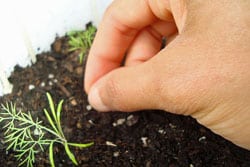Consumer’s wallets have tightened significantly since 2008, when the global economic slowdown started, led by the food safety scares of tomatoes and peppers during that summer.
2009 is the first year that fruit and vegetable sales have dropped, with fruit down 12% and vegetables down 6%. The trend is from more expensive fruit and veggies to less expensive ones, as everyone is trying to make their dollar go farther. What is even more interesting is that the volume is up of fruits and vegetables, but the sales or profit is down. One explanation is people are eating out less, which decreases the profits to the retailers. Another is that people are gardening a lot more, growing some of their own food, especially the more expensive vegetables, and buying the less expensive ones. As an example, weekly dollar sales of packaged salads fell by nearly 5%, while bulk lettuce sales rose by 6.9% in 2009.
The increase in gardening has been driven by a concern by consumers over prices and overall food safety. The National Gardening Association states that there is a multitude of reasons people are gardening in increasing numbers, including the state of the economy, increased costs of food and that “food safety is a huge issue in the US. People mistrust producers of food so if you grow your own you can control the inputs like fertilizer.” CNN reports that there were 43 million vegetable gardens planted in 2009, with 19% of households growing some of their own fruit, vegetables and herbs are first timers. $100 spent on seed can save you up to $2500 at the grocery store, according to a couple of studies in 2008 where vegetables were planted, grown and weighed, then compared to local grocery store prices for an entire season. That figure is probably even more now, with food prices increasing.
On April 22, 2010 the National Inflation Association issued the following food inflation alert-
The Bureau of Labor Statistics (BLS) today released their Producer Price Index (PPI) report for March 2010 and the latest numbers are shocking. Food prices for the month rose by 2.4%, its sixth consecutive monthly increase and the largest jump in over 26 years. NIA believes that a major breakout in food inflation could be imminent, similar to what is currently being experienced in India.
Some of the startling food price increases on a year-over-year basis include, fresh and dry vegetables up 56.1%, fresh fruits and melons up 28.8%, eggs for fresh use up 33.6%, pork up 19.1%, beef and veal up 10.7% and dairy products up 9.7%. On October 30th, 2009, NIA predicted that inflation would appear next in food and agriculture, but we never anticipated that it would spiral so far out of control this quickly.
Elizabeth Pivonka, President and CEO of the Produce for Better Health Foundation says in the Feb 2010 issue of Seed World, “There are still many fruit and vegetable growers and shippers that continue to struggle to stay in business. Food safety initiatives, including the cost of traceability are some of their biggest expenses right now, along with trying to cope with any other types of legislation that always cost money (for example, water issues on the west coast, immigration issues and cap and trade.) Finally, just overall profitability is an ongoing concern- it’s a shame that the fruit and vegetable industry doesn’t make the profit margins other products make so that they can better market themselves.”
This is very telling, as the costs of commercial food production, regardless of the sector, continue to rise due to more and more legislation aimed at making the food produced safer. This is in direct contrast to the costs in a local food system, as the transport costs are very small, and the quality and health of the food is significantly higher, eliminating the need for increased legislation to attempt to force the safety into the food production system. The safety and quality are inherent, as producer, shipper and retailer are often one and the same. If the quality and safety are missing, the consumer simply won’t buy, which has a much greater impact on the producer. Thus the closeness and openness of the local food system works to increase the quality, health and safety of the locally produced foods.
This is one of the main reasons that local food and local agriculture- that grown and consumed within a 100-200 mile radius- has been increasing in volume and sales for the past several years. People can see what they buying, talk to and get to know the person who grew or raised their food. They get to actively participate in making the decision for better food that is raised or grown in healthy ways and has better flavor and nutrition than industrial food producers.
What better time or reasons to eat locally?












